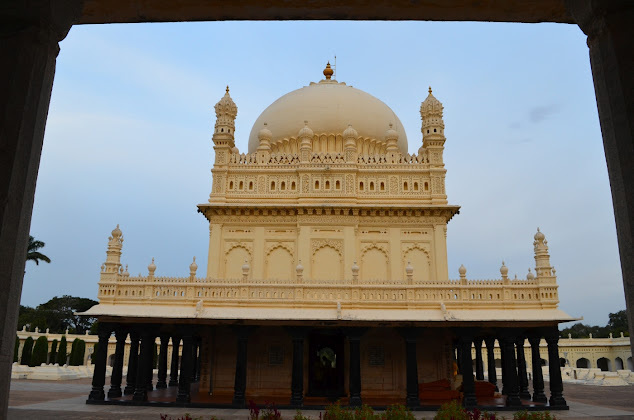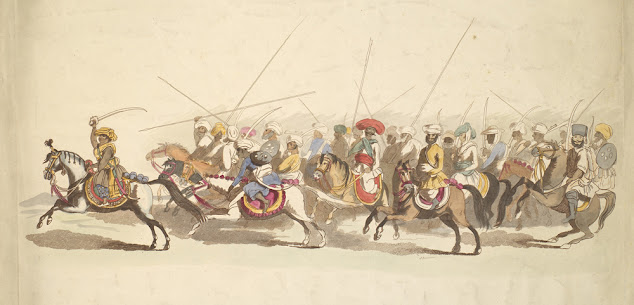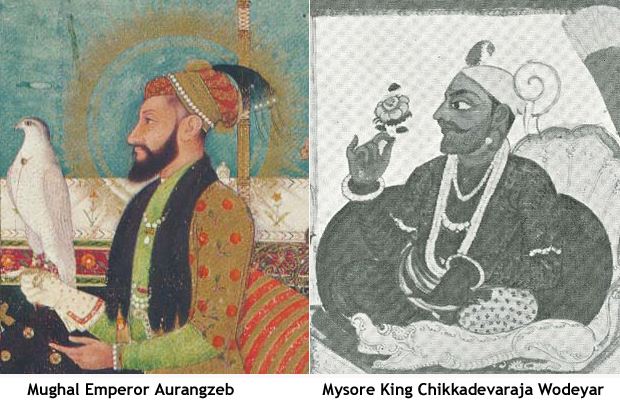Fight for freedom in south India - Srirangapatna uprising of 1857 CE
Research and author: Ameen Ahmed
The Vellore Mutiny by late Tipu's family and his supporters in 1806 CE is quite familiar to history lovers in this part of the world. What is not known is that 58 years after his death people of Srirangapatna gathered at Tipu Sultan's mausoleum and hope to free India from the clutches of British imperialism. In this story let's learn about a rare spark of India's first war of independence in the country's south and how it is connected to the practise of a martial race of India being allowed to carry weapons to this day.
The year 1857 CE is widely considered as India's beginning of fight for its freedom from British occupation. In that sense people who participated in this struggle are considered as India's earliest freedom fighters. Mistrust and conflicts are fertile wombs for rumours. A rumour circulating across British India in the run up to 1857 CE was the English wanted to forcibly convert India's Hindus and Muslims into Christianity. Indian soldiers believed they were forced to lick the fat of pig and cow in order to use their firearms, which led to them revolting against their British masters. Hostilities spread like a wildfire across what today is northern India and Pakistan. But hardly any literature is present on the conflict spreading south of the Vindhyas. All of India's kingdoms were firmly under British control. Some native rulers like the Nizam of Hyderabad and the Chiefs of Coorg actively supported the British in suppressing the 1857 revolt. One British author writes 'Of all the native princes who stood firmly beside England in the greatest crisis of her Indian history, the Nizam, whose territory bears the name of The Nizam's Dominions'. (1)
Following the pattern of rumours, a masjid (mosque) in Delhi sent a letter to a masjid in Mysore. It claimed the Christian pastors had written to the Queen of England seeking her 'permission to forcibly convert India's Muslims into Christianity'(2). The kingdom in 1857 was known as Mysore Commission and was under direct British administration. Mark Cubbon was the Commissioner of the province. Around the same time many Muslims around Srirangapatna gathered at the mausoleum of Tipu and Haidar Ali to pray and share their aspirations of driving the British from Mysore Kingdom (3). Srirangapatna was the capital of Mysore Kingdom until Tipu Sultan's martyrdom on battle field there in 1799. According to another British Raj document, in 1857 Mark Cubbon learnt that Muslims of Srirangapatna had risen up in support of the revolt in Delhi. He secretly instructed Coorgi chiefs to led their men to suppress the revolt. The armed Coorgis followed the instructions of their British masters and put down the revolt at Periyapatna, a few kilometres west of Srirangapatna.
In recognition of them helping suppress the Srirangapatna mutiny, Mark Cubbon, then Chief Commissioner of Mysore Commission issued the following Proclamation:
"In consideration of the exalted honour, loyalty, and intrepidity characteristic of this little nation of warriors, and in recollection of its conspicuous services in aid of the British Government, it is my pleasing duty to notify hereby for general information, in virtue of the power vested in me by the Government of India, that the provisions of the Act, commonly called the Disarming Act, are not applicable to the gallant people of Coorg." (4)
While the British authors have referred to this uprising as one by 'Muhammadans', there are no accounts by the other side to know the true composition of people who rose against the British. It is to be remembered that it was common for British Raj authors to label many uprisings against the Raj as 'Muslim uprisings'. For example, Henry Harrington-Thomas wrote in 1858 'The Mahomedans planned and organised this rebellion (or rather revolution) for their own aggrandizement alone: and their Hindoo Sepoys of the Bengal army were their dupes and instruments.' (5) In view of this it will be interesting to find alternate views of the Srirangapatna uprising of 1857 to understand whether it was a united effort by disaffected Mysoreans of all sections of society or just a 'Mohammaden uprising' as the British termed it.
Sources:
The year 1857 CE is widely considered as India's beginning of fight for its freedom from British occupation. In that sense people who participated in this struggle are considered as India's earliest freedom fighters. Mistrust and conflicts are fertile wombs for rumours. A rumour circulating across British India in the run up to 1857 CE was the English wanted to forcibly convert India's Hindus and Muslims into Christianity. Indian soldiers believed they were forced to lick the fat of pig and cow in order to use their firearms, which led to them revolting against their British masters. Hostilities spread like a wildfire across what today is northern India and Pakistan. But hardly any literature is present on the conflict spreading south of the Vindhyas. All of India's kingdoms were firmly under British control. Some native rulers like the Nizam of Hyderabad and the Chiefs of Coorg actively supported the British in suppressing the 1857 revolt. One British author writes 'Of all the native princes who stood firmly beside England in the greatest crisis of her Indian history, the Nizam, whose territory bears the name of The Nizam's Dominions'. (1)
Following the pattern of rumours, a masjid (mosque) in Delhi sent a letter to a masjid in Mysore. It claimed the Christian pastors had written to the Queen of England seeking her 'permission to forcibly convert India's Muslims into Christianity'(2). The kingdom in 1857 was known as Mysore Commission and was under direct British administration. Mark Cubbon was the Commissioner of the province. Around the same time many Muslims around Srirangapatna gathered at the mausoleum of Tipu and Haidar Ali to pray and share their aspirations of driving the British from Mysore Kingdom (3). Srirangapatna was the capital of Mysore Kingdom until Tipu Sultan's martyrdom on battle field there in 1799. According to another British Raj document, in 1857 Mark Cubbon learnt that Muslims of Srirangapatna had risen up in support of the revolt in Delhi. He secretly instructed Coorgi chiefs to led their men to suppress the revolt. The armed Coorgis followed the instructions of their British masters and put down the revolt at Periyapatna, a few kilometres west of Srirangapatna.
In recognition of them helping suppress the Srirangapatna mutiny, Mark Cubbon, then Chief Commissioner of Mysore Commission issued the following Proclamation:
"In consideration of the exalted honour, loyalty, and intrepidity characteristic of this little nation of warriors, and in recollection of its conspicuous services in aid of the British Government, it is my pleasing duty to notify hereby for general information, in virtue of the power vested in me by the Government of India, that the provisions of the Act, commonly called the Disarming Act, are not applicable to the gallant people of Coorg." (4)
While the British authors have referred to this uprising as one by 'Muhammadans', there are no accounts by the other side to know the true composition of people who rose against the British. It is to be remembered that it was common for British Raj authors to label many uprisings against the Raj as 'Muslim uprisings'. For example, Henry Harrington-Thomas wrote in 1858 'The Mahomedans planned and organised this rebellion (or rather revolution) for their own aggrandizement alone: and their Hindoo Sepoys of the Bengal army were their dupes and instruments.' (5) In view of this it will be interesting to find alternate views of the Srirangapatna uprising of 1857 to understand whether it was a united effort by disaffected Mysoreans of all sections of society or just a 'Mohammaden uprising' as the British termed it.
Sources:
1) John F Hurst, 'Indika', 18912) Major-General Macleod, 'On India', 18723) Lewin B Bowring, 'Haidar Ali and Tipu Sultan and the struggle with the Musalman powers of the South', 18934) India Office. 'Copy or Extracts of Correspondence between the Secretary of State for India and the Governor General, regarding the Re-establishment of a native government in Mysore by the time the Maharajah shall come of Age in 1880.', Return. East India (Mysore Government). Ordered, by the House of Commons, to be printed, 14 August 18785) Henry Harrington-Thomas, 'The Late Rebellion in India, and Our Future Policy', Pp. 13-17 (London)







It is well written and it gives the struggle of the people of south for the independence of India
ReplyDeleteFine and very relevent, helps to dig the historical facts, for those who are worthful to know....
ReplyDelete